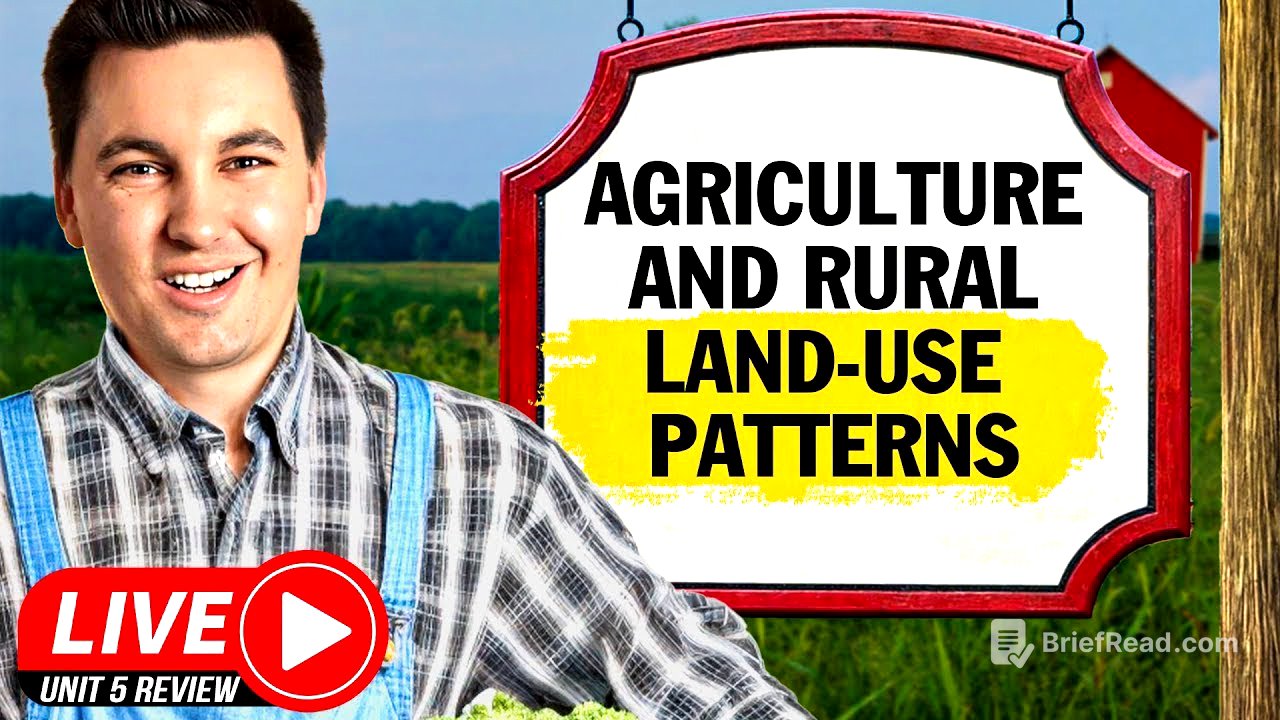TLDR;
This YouTube video by Mr. Sinn provides a comprehensive review of Unit 5 in AP Human Geography, focusing on agriculture. It covers essential topics such as the origins of agriculture, intensive and extensive farming practices, agricultural revolutions, consequences of the Green Revolution, settlement patterns, survey methods, globalization and agriculture, and contemporary challenges like food deserts and sustainability. The video also touches on economic development, gender roles in agriculture, and the impact of government policies.
- Origins of agriculture and diffusion
- Intensive vs. extensive farming
- Agricultural revolutions and their impacts
- Consequences of the Green Revolution
- Settlement patterns and survey methods
- Globalization and agriculture
- Contemporary challenges and solutions
Introduction to Agriculture [0:00]
The video starts by introducing the topic of agriculture and mentioning upcoming live streams for review sessions. It emphasizes the importance of understanding where crops originated and how different crops are produced based on site factors. The distinction between site (absolute location) and situation (relative connections) is highlighted to avoid confusion on the test.
Intensive vs. Extensive Farming [1:27]
The video explains the two main types of farming: intensive and extensive. Intensive farming uses less land, more capital (money, machinery), and is located closer to population centers due to the perishable nature of its products. Extensive farming uses more land, less labor, less capital, and is located farther from markets. The importance of understanding these differences is stressed as they appear throughout the unit.
Types of Intensive Farming [2:58]
The video lists and defines different types of intensive farming, including plantation agriculture, mixed crop and livestock, and market gardening. Plantation agriculture is typically located in less economically developed countries (periphery and semi-periphery) and produces crops for core countries due to cheaper labor. Market gardening, also known as truck farming, relies on preservatives and varying growing seasons to ship products across the country. Mixed crop and livestock farming helps distribute work and income throughout the year.
Cash Crops and Arable Land [4:51]
The video defines cash crops as crops grown for sale rather than consumption by the farmer. The increasing shift towards cash crops in less economically developed areas can lead to food shortages as arable land (fertile farmland) is diverted for export production instead of local food needs.
Types of Extensive Farming [6:13]
The video outlines different types of extensive farming practices, including shifting cultivation, nomadic herding, and ranching. Shifting cultivation involves slash and burn agriculture, where trees are cut down and burned to add nutrients to the soil before planting crops. Nomadic herding involves moving with livestock in search of food and water sources, typically in areas unsuitable for sedentary agriculture. Ranching is often found in more economically developed areas due to the large amount of land required.
Fallow Land and Yield [9:26]
The video defines "fallow" as intentionally leaving land uncultivated to restore nutrients and fertility, commonly seen in slash and burn agriculture. "Yield" refers to the amount of agricultural production in a specific area.
Settlement Patterns [10:12]
The video reviews three settlement patterns: clustered, linear, and dispersed. Clustered settlements have buildings packed closely together, while dispersed settlements have significant space between buildings. Linear settlements are arranged in a line, often along a road, railroad, or river. The impact of these patterns on access to resources, services, and economic opportunities is discussed.
Survey Methods: Long Lots, Meets and Bounds, Township and Range [12:09]
The video explains three survey methods: long lots, meets and bounds, and township and range. Long lots are narrow parcels of land, often connected to a waterway, used to ensure everyone had access to transportation. Meets and bounds uses landmarks to define boundaries, resulting in irregular shapes. Township and range, used in the United States, creates a grid-like pattern using longitude and latitude, making land sales and ownership identification easier.
Agricultural Revolutions and the Columbian Exchange [15:33]
The video discusses the agricultural revolutions, starting with the first agricultural revolution (Neolithic Revolution), which marked the transition from nomadic to sedentary life. The Columbian Exchange is highlighted as a significant diffusion event where crops, livestock, and diseases were exchanged between the New World and the Old World. The potato's impact on population growth in Europe is mentioned as an example.
Second Agricultural Revolution and Malthusian Theory [19:41]
The second agricultural revolution coincided with the Industrial Revolution, leading to innovations like the seed drill and threshing machines. The enclosure movement, where communal land became private, increased production but also displaced farmers, leading to rural-to-urban migration. This revolution disproved Malthus's theory of overpopulation by demonstrating increased food production capabilities.
The Green Revolution [24:47]
The Green Revolution involved a significant increase in agricultural production due to high-yield crop varieties (hybrid seeds), chemical fertilizers, pesticides, and modern irrigation. Norman Borlaug is credited as the father of the Green Revolution for his work with semi-dwarf wheat. The video also defines fertilizers, pesticides, and herbicides.
Consequences of the Green Revolution [27:14]
The video discusses the negative consequences of the Green Revolution, including environmental degradation, water depletion, loss of agricultural biodiversity (monocropping), and economic dependence on core countries for resources like machinery and fertilizers.
Monocropping, Biodiversity, and Subsistence vs. Commercial Agriculture [29:55]
Monocropping, the practice of cultivating a single crop year after year, is driven by profitability but reduces biodiversity and depletes soil nutrients. Subsistence agriculture involves producing food for oneself or the local community, while commercial agriculture focuses on producing for profit.
Large-Scale Commercial Agriculture and Commodity Chains [31:47]
Large-scale commercial agriculture utilizes advanced technologies like geospatial technology, GPS, and satellite imagery. Commodity chains describe the path a commodity takes from raw form to consumer, involving various factors and processes.
Carrying Capacity and Economies of Scale [33:56]
Carrying capacity is the maximum number of organisms an area can support sustainably. Economies of scale refer to the reduction in individual cost due to increased production volume, often seen in large companies that own their production facilities.
Agribusinesses and GMOs [36:17]
Agribusinesses are large businesses producing food, while GMOs (genetically modified organisms) involve genetically engineering food, differing from hybrid seeds that use crossbreeding.
Bid Rent Theory [37:04]
The bid rent theory explains that land prices are higher closer to cities due to increased demand and limited supply. This theory connects to intensive and extensive agriculture, influencing where different farming practices are located.
Von Thünen's Model of Land Use [41:09]
Von Thünen's model explains the spatial arrangement of agricultural activities around a market, with perishable and heavy goods (like dairy and wood) located closer to the market. The model assumes uniform land characteristics, an isolated state, and farmers aiming to maximize profit.
Globalization in Agriculture: Supply Chains, Interdependence, and Commodity Dependence [44:01]
Globalization in agriculture involves complex supply chains and interdependence among countries. Commodity dependence occurs when a country's exports are heavily reliant on commodities, creating economic vulnerability. Net importers bring in more food than they export, while net exporters do the opposite.
Global Food Demand and the Ukraine-Russia War [47:34]
The video discusses the growing global demand for food and the challenges of improving farming sustainably. The Ukraine-Russia war is used as an example of how global distribution of food can be disrupted, impacting food prices and fertilizer availability.
Consequences of Global Agriculture: Deforestation, Pastoral Nomadism, and Irrigation [51:06]
The video covers various consequences of global agriculture, including deforestation, pastoral nomadism (herders migrating with livestock), and irrigation (which can lead to soil salinization).
Soil Erosion, Terrace Farming, and Draining Wetlands [52:09]
Soil erosion, the displacement of the upper soil layer, can lead to loss of arable land and desertification. Terrace farming modifies land by building into hillsides. Draining wetlands for urbanization can disrupt natural filtration systems and increase water runoff.
Soil Salinization, Aquaculture, and Economic Development [54:09]
Soil salinization is the accumulation of salt in the soil, often caused by over-irrigation. Aquaculture involves rearing aquatic animals, but can decrease biodiversity. Economic development impacts diets, with increased meat consumption and luxury products as income rises.
Contemporary Challenges in Agriculture [56:00]
Contemporary challenges include sustainability, soil and water usage, reduction in biodiversity, use of fertilizers and pesticides, feeding the global population, loss of arable land, and climate change.
Food Deserts [56:39]
Food deserts are communities lacking access to fresh and healthy food, leading to health issues like diabetes and obesity. This is a food distribution problem requiring solutions.
Community Supported Agriculture, Organic Farming, and Fair Trade [57:51]
Community Supported Agriculture (CSA) directly supports local farmers. Organic farming uses natural methods without antibiotics or chemical fertilizers. Fair trade ensures more proceeds go to the producers, especially in less economically developed areas.
Value Added Crops and Government Subsidies [1:00:59]
Value-added crops increase in value during production, like strawberries turned into strawberry jam. Government subsidies are financial incentives to create a particular industry, impacting food production and trade.
Women in Agriculture [1:01:34]
As economic development occurs, more women move from the informal to the formal economy. Less economically developed areas often have women in agricultural roles, but with limited land ownership and credit access. Micro-lending can help counter this.
Conclusion [1:02:59]
The video concludes by summarizing the main points of Unit 5 and promoting additional resources for further study. Upcoming live streams for other units are also announced.









